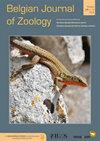法国奥德河濒临灭绝的比利牛斯山鸡(Galemys pyrenaicus)遗传监测
IF 1.1
4区 生物学
Q2 ZOOLOGY
引用次数: 9
摘要
比利牛斯山鼬(Galemys pyrenaicus)是比利牛斯山脉和伊比利亚半岛北半部特有的一种小型半水生哺乳动物。这一物种目前被列入世界自然保护联盟红色名录,几十年来一直遭受栖息地丧失和破碎化的困扰,但人们对水力发电厂引起的水流改变的影响知之甚少。为了解决这一问题,我们通过对被困动物的粪便样本和毛发进行基因分型,监测了生活在奥德河一段脊甲地区的比利牛斯野驴个体。在一项为期三年的研究(2011-2013年)中,利用24个微卫星位点共鉴定了39个个体,其中28个来自粪便,11个来自被困动物。几次长距离移动至少达到15公里,这是以前从未报道过的距离。这些移动可能与在修复恩蒂拉水电站期间发生的非常高的水流引起的河床变化有关。当地的种群密度表明,奥德河为比利牛斯山德斯曼提供了适宜的栖息地,保护这一栖息地应成为保护该物种的优先事项。本文章由计算机程序翻译,如有差异,请以英文原文为准。
Genetic monitoring of the endangered Pyrenean desman (Galemys pyrenaicus) in the Aude River, France
The Pyrenean desman (Galemys pyrenaicus) is a small semi-aquatic mammal endemic to the Pyrenean Mountains and the northern half of the Iberian Peninsula. This species is currently considered as vulnerable in the IUCN Red List and has been suffering from habitat loss and fragmentation for decades but little is known about the impact of water flow modifications induced by hydroelectric power plants. In order to address this issue we monitored Pyrenean desman individuals living in a harnessed section of the Aude River, by genotyping both faeces samples and hair of live-trapped animals. During a three-year study (2011-2013), a total of 39 individuals were identified using 24 microsatellite loci, 28 from faeces and 11 from trapped animals. Several long distance movements were evidenced up to at least 15 km, a distance that has never previously been reported. These movements might be related to modifications of the river bed caused by very high water flows that occurred during the repair of the Nentilla hydroelectric plant. The local population density suggests that the Aude River provides suitable habitat for the Pyrenean desman, and preservation of this habitat should be a priority for the conservation of this species.
求助全文
通过发布文献求助,成功后即可免费获取论文全文。
去求助
来源期刊

Belgian Journal of Zoology
生物-动物学
CiteScore
1.90
自引率
0.00%
发文量
10
审稿时长
>12 weeks
期刊介绍:
The Belgian Journal of Zoology is an open access journal publishing high-quality research papers in English that are original, of broad interest and hypothesis-driven. Manuscripts on all aspects of zoology are considered, including anatomy, behaviour, developmental biology, ecology, evolution, genetics, genomics and physiology. Manuscripts on veterinary topics are outside of the journal’s scope. The Belgian Journal of Zoology also welcomes reviews, especially from complex or poorly understood research fields in zoology. The Belgian Journal of Zoology does no longer publish purely taxonomic papers. Surveys and reports on novel or invasive animal species for Belgium are considered only if sufficient new biological or biogeographic information is included.
 求助内容:
求助内容: 应助结果提醒方式:
应助结果提醒方式:


